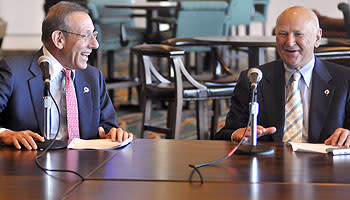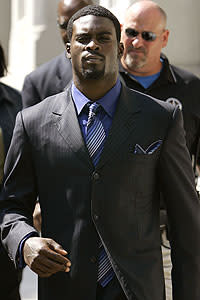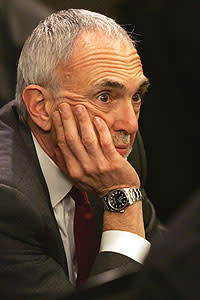CBA figures to be hot topic during meetings
NFL owners will gather in Atlanta Tuesday to decide where the Super Bowl in February 2012 will be played. This will take place in conjunction with them plotting a mission that could lead to the cancellation of that very game and the preceding season.
One of the many issues owners will discuss is the evolving strategy regarding the collective bargaining agreement with the league's players. Right now, the plan appears pretty straight forward: opt out of the agreement in November.
Opting out of the agreement triggers many things, including the possibility that there will not be a salary cap in the 2010 season and that the terms of the agreement will cease after that season. If that happens, the NFL Players Association expects the owners to attempt a lockout of the players, starting in March 2011. A lockout could ultimately threaten the 2011 season.
This, of course, is the doomsday scenario – one that seems to defy common sense given the apparent success of the NFL.
"Everybody is doing well right now, the players and the owners," Indianapolis Colts center and NFLPA player representative Jeff Saturday said in February. "For us to not be able to work this out … I don't think the fans would be very understanding of that."
Saturday's comments are similar to many other players' and were echoed by New England owner Bob Kraft.
"Both sides have a duty to work together in these talks because we are doing very well," Kraft said. "Hopefully both are smart enough to make that happen."
However, Kraft and his brethren also are claiming that ownership is losing money. On May 8, representatives of the NFL and NFLPA met in New York for an initial discussion of the CBA, according to NFLPA executive director Gene Upshaw. On the union's website, Upshaw gave a synopsis of the meeting, which included Carolina Panthers owner Jerry Richardson, Denver Broncos owner Pat Bowlen, the league's financial team and Bob Batterman, who has been hired as outside counsel by the league.
"The NFL discussed the 32 teams' financial condition and how the CBA has caused every club to lose money," Upshaw wrote. "They are attempting to gather financial information to share with the NFLPA. We made it clear that we are willing to discuss their financial condition, but we cannot expect our players to embrace the NFL's position without the owners providing audited financial statements. This is just the first step in the process."

Dolphins co-owners Huizenga (right) and Ross.
(AP Photo/David J. Phillip)
The problem with accepting the notion that NFL teams are losing money is that franchise values have never been higher. In February, owner Wayne Huizenga sold 50 percent of the Miami Dolphins and the stadium they play in to real estate magnate Stephen Ross for $550 million. This is the same franchise that Huizenga bought in 1993 for a total of $168 million. Over the years, Huizenga has spent approximately $250 million in stadium and other facility upgrades. Even with that cost, the value of team has nearly tripled over 15 years.
"All the union needs to do is put up copies of that story (about the sale of the Dolphins) and you'd think the owners would be done," a union source said. "To hear the owners crying about losing money seems pretty far-fetched."
Especially considering what's taking place in New England. Kraft is in the midst of building Patriot Place adjacent to Gillette Stadium in suburban Foxborough, Mass. Patriot Place is a huge shopping complex complete with a Marriott hotel. If business wasn't good with the football team, would Kraft be making such an investment?
In addition, most teams are well under the salary cap. According to NFLPA figures (which are regularly checked with figures kept by the NFL), each of the 32 NFL teams is an average of $12 million under the salary cap for the 2008 season. Even after this year's draft picks are signed and other contracts are done, it's expected that the average team will be roughly $6 million under the cap when the season starts.
So essentially, spending on players is not the problem.
Still, there are plenty of indications that the owners are getting ready for a fight and the union is gearing up. From complaints by owners to legal proceedings to letters by league personnel instructing owners to control debt, the NFL is proceeding in what appears to be a very carefully constructed fashion.
"There's going to be a much more united and planned front from ownership this time," one team executive said recently. "The last time (2006), the union was very successful at splitting the NFL family into factions. That's not what is going to happen this time."
Perhaps, but there is one crucial question the owners must face: Can they really get the leverage required to beat a union that over the past two decades has turned the tables on the power structure? Under the guidance of Upshaw, NFL players now make the largest percentage of gross revenues (59) compared to their counterparts in Major League Baseball (53), the National Basketball Association (57) and National Hockey League (55.6), according to figures provided by the NFL, an NFLPA source and an article in Sports Business Journal. More importantly, unless the NFL is able to get the federal courts to discontinue their supervision of the labor negotiations, the union will likely continue to hold its cache of power.
And, as Upshaw said in April, it's not giving it up.
"I don't think the leverage has changed at all and I don't think it will change," Upshaw said. "What hasn't changed is that they say they can't live by their (41) percent. But we don't hear one message about what they think is wrong. They haven't defined (what they think is wrong and what needs to be solved)."
TENSION WITHIN OWNERSHIP GROUP
Last July, the Dallas Cowboys opened training camp in San Antonio. The event was kicked off with a pep rally at the Alamodome, where the team practiced. More than 20,000 people showed up for the event, which included a performance by Los Lonely Boys.
For the rest of training camp, fans and players got to enjoy the air-conditioned comfort of the dome. Aside from the practices, the Cowboys sold souvenirs and memorabilia. The field was lined with placards for all of the Cowboys sponsors and two brand-new Ford trucks sat on the sidelines, only a few feet from the blocking sleds.

Jones watches his team from the sidelines.
(Getty Images)
It's all part of the way that owner Jerry Jones has done business since he bought the Cowboys in 1989. Jones has carved out a niche as the P.T. Barnum of the NFL. Everything is a show and everything is an opportunity to make money, even the way the Cowboys practice. After practices, Jones plays to the crowd, signing more autographs than the players, doing it all with a congenial smile and spicing it all with folksy exchanges with the fans.
Jones has turned Dallas' status as one of the league's elite teams into a cash cow. Other teams, such as the Patriots and Washington Redskins, have followed his lead. But where Jones is the host wanting the most, many other franchises continue to take a more languid approach to making money, a fact that infuriates the likes of Jones.
For example, Cincinnati Bengals owner Mike Brown refuses to sell the naming rights to the team's current home, which opened in 2000 and was financed through a county sales tax. Brown gets all of the money generated by the stadium. However, he passes on the millions of dollars he could make for naming rights, preferring to keep the stadium named after his father, Hall of Fame coach Paul Brown.
"That's where you start to get the big fight among the owners," said one source familiar with the CBA negotiations. "Jerry Jones will tell you that he really likes Mike Brown. But when it comes to sharing revenue, Jerry gets upset and basically says, 'Why should I share with Mike Brown if he's not going to work as hard as me to make money?' "
That question is at the root of problems between ownership. In the NFL, the main source of revenue is television money and that is shared among the 32 teams. Over the years, however, there has been a growing disparity in other money made by teams, from corporate sponsorship to local television and radio rights fees. When those are included, teams such as Dallas and Washington far outstrip the likes of the Pittsburgh Steelers and Minnesota Vikings when it comes to earning power.
However, that money goes into the pool of what is defined as "total football revenue" in the CBA. Regardless of how much each franchise makes, all of the money counts toward TFR with the players receiving 59 percent.
The issue there is that the top-earning teams make it difficult for the lower-earning teams to keep pace with the salary cap. At least that's how the argument goes. In 2006, the NFL tried to resolve that by having increased revenue sharing. However, that has caused resentment among the owners who are forced to share.
From the players' perspective, the talk that the owners now want to renegotiate the CBA smacks of the owners asking the players to solve the revenue-sharing problems.
"The message we keep getting is that we're somehow supposed to take less because they don't know how to share their part of the pie," Denver Broncos safety John Lynch said. "In our view, that's not our responsibility. That's an issue for ownership to work out."
Ownership counters that by saying that current economic concerns and heavy investments by some owners have put them in a difficult position.
"All of the risk lies with the owners right now," one team executive stated. "They're the ones putting all the money up front for new construction. The players assume none of the risk if there's a huge economic downturn or, worse, if there were some terrorist attack on a stadium."
Attorney Gregg Levy, who has represented the NFL in labor matters for approximately 20 years, recently sent a letter to all owners claiming that NFL teams were averaging $231 million in debt currently. Levy advised owners to get debt control quickly.
Jones is among those facing debt issues because he is building a new stadium just outside Dallas that is considered stunningly luxurious – with a $1 billion price tag. The stadium, with a standard capacity of 80,000 but could approximately expand to 100,000 fans, will host the Super Bowl on Feb. 6, 2011.
Coincidentally, that could be the NFL's last true game before the labor situation gets really ugly.
LEGAL PROCEEDINGS
Upshaw and others in the NFLPA are preparing for owners to lock out players in March 2011. In essence, the owners say they can't proceed with the game under the current agreement. To get to that point, the owners need to opt out of the CBA Nov. 8 and then endure the uncapped season of 2010, when there would essentially be no limits on spending for players.
Opting out by the owners is basically signed and sealed deal at this point. In fact, the agreement was basically built with opting out as the way to go. Under the CBA extension of 2006, 24 of 32 owners would have to vote to continue the deal as it's currently structured. However, that's not the only measure taken by the owners.
On Feb. 14, the NFL took its most significant step by filing a motion with U.S. District Court Judge David Doty asking Doty to disqualify himself from handling the class-action lawsuit that led to the CBA in 1992. Doty has overseen the case since it was assigned to him in 1992. Doty rejected the motion.

Owners are unhappy with the Vick ruling.
(AP Photo/Haraz N. Ghanbari)
The basis for the motion revolves around Doty's decision on Feb. 4 that allowed jailed and suspended Atlanta Falcons quarterback Michael Vick to keep nearly $20 million in bonus money paid by the Falcons. The decision reversed an arbitrator's ruling in November that gave the money back to the Falcons after Vick pleaded guilty to federal charges related dog fighting.
Furthermore, the NFL argued in its motion that Doty has shown bias toward the union by holding private meetings with the union staff and attorneys in his chambers before several hearings.
Ultimately, the NFL wants the entire court system to be removed from the labor process. In the February motion, the league stated in its argument that "the time has long since passed to put an end to this Court's supervision of labor relations in the NFL." The league argued that the current strength of the union meant that oversight was unnecessary. Both commissioner Roger Goodell and league counsel Jeff Pash acknowledged this week that getting Doty and the federal courts off the case is the goal.
"Either Judge Doty or the Court of Appeals (can say) it's appropriate to end court oversight of the bargaining process," Pash said.
Like Doty, the union would likely counter that the NFL has grown so drastically because of court supervision, not in spite of it. As both Saturday and Kraft indicated, it's hard to argue that the league is suffering in any way. For instance, the NFL announced earlier this offseason that it again broke its attendance records.
Most important, the union also has the right in the CBA to return to court and retained the right to decertify as a union in order to return to federal court.
WHO HAS THE LEVERAGE?
Thus, all of the actions starting in November with the owners and then flowing through the courts will ultimately define who has the leverage. In short, this is how it works:
• The NFL votes to opt out of the agreement in November 2008. Talks between the sides on an extension will reopen, but little progress is expected at this point unless a new deadline for an agreement is set. In 2010, the league has an uncapped year for salaries. In March 2011, the CBA expires.
• From there, the best guess by people on both sides is that the owners would try to lock out the players in March 2011, effectively eliminating free agency and the payouts that go with that. The union has anticipated that by telling the player representatives at its annual meeting in March that players needed to begin saving money and reducing debt themselves by that time.
• Upon being locked out, the NFLPA would presumably decertify as a union, making players free individuals who aren't subject to collective bargaining and therefore can't be locked out. The players, as they did in the early 1990s, would then file a class-action suit against the league saying that such a lockout would be an anti-trust violation.
Again, that's only if the court continues supervision. This is where the owners are working to change the dynamic and where the union is hoping to preserve the current state.

Batterman was involved in the NHL's lockout.
(Getty/Bruce Bennett)
In related news, the hiring of Batterman by the league has been an intriguing development. Batterman, who has 25 years of experience in sports labor law, recently assisted the NHL when it locked out players in the longest work stoppage in sports history, costing the league the 2004-05 season.
While some people believe Batterman's presence means the owners are gearing up for a work stoppage, others believe he could be there to help convince NFL owners of the folly of a lockout.
"The NFL is in a position where it's making money right now," one source said. "It's far different from where the NHL was in 2004, when teams were losing money and franchise value was next to nothing. If the NFL locks out players and starts missing games, you're talking about the league taking massive losses in income."
Here's the basic equation: Every percentage of the total football revenue equates to roughly $2.5 million per team on the salary cap. The belief by the union's side is that teams will lose far more than that for every game that is missed if a lockout goes into the regular season.
Thus, the union believes it clearly has the leverage. Based on the uncomfortable reaction of four NFL owners and/or executives to the question of who has the leverage, it seems that's the case.
"If this becomes an issue about who has the leverage, then neither side wins," one owner said. Seeing as how the NFL owners have continually leveraged the television networks into giving them what they want, that response seemed almost comical.
"Every deal is about leverage and we all know that," a team executive said recently. "Are (the owners) going to be able to change it? We'll see. I don't think so and even if they do, it's going to take a long time."
Or as New York Giants owner John Mara said: "I don't know the answer to that. I guess we'll find out."
